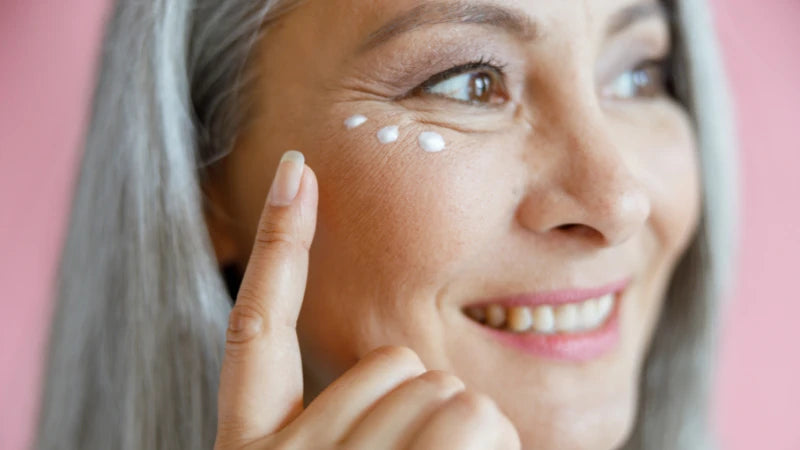Blog
Do You Really Need Eye Cream? Or Is It a Scam?
Do you really need an eye cream? We think so, which is why we’re so excited to announce the arrival of Active Eyes, our specialized retinol peptide eye serum. More than just another moisturizer, Active Eyes is a powerful (yet gentle) age-beautifying serum that reduces the look of lines around the eye area. It also nourishes for firmer, smoother, brighter and hydrated skin, and is suitable for all skin types. Shop Active Eyes But, what if your beauty counter is already overflowing with serums, moisturizer, cleansers and toners? Is it worth your time, effort and money—not to mention the real estate on your bathroom counter— to add an eye treatment to your skin care routine? The answer may surprise you. What Is the Purpose of Eye Cream? An eye cream is a treatment that’s been specifically formulated to target skin concerns under the eye, on the eyelid and the skin around the eye. Some of the ingredients may be like those you’ll find in other creams or serums designed to be used on the face, but they may be present in a lower concentration to ensure that it’s safe for the delicate skin around the eyes. Skin isn’t just skin, and different parts of your body are covered with different types of skin. Eyelid skin is thinner and more fragile than the skin on the rest of your body and because of this, it shows signs of aging sooner than other areas of your face. It also doesn’t have any oil glands so needs more moisture to prevent dryness. Gentle care is non-negotiable. Active Eyes Serum What Ingredient Is Best for Under Eye? Choosing the right ingredients depends on your skin concerns. And whether it’s dark circles, fine lines, crepiness or undereye puffiness, if you’re starting to notice changes to your undereye area, then you should consider using a dedicated treatment. 1. How Can I Remove Dark Circles Under My Eyes? Lack of sleep, but also allergies or the natural aging process may be the reason for dark circles, which also tend to be more common amongst people of color. They may look purple or blue to dark brown or black in color, and while they’re rarely cause for concern, you may want to reduce their appearance for cosmetic reasons. Getting adequate sleep or changing your diet can improve dark circles. But, if they’re a result of aging, due to a loss of thinning skin, reduced fatty tissue, hyperpigmentation, or sun damage, you’ll need a treatment with ingredients that help to brighten the area. Niacinamide, antioxidants like vitamins C and E, and specialized brightening agents, like white bark extract (found in Active Eyes) are just a few examples of ingredients that can help. 2. How Do I Get Rid of the Wrinkles Under My Eyes? The best ingredient to help minimize the appearance of wrinkles and fine lines is a retinoid. Active Eyes contains a stable, encapsulated form of retinol, at a concentration suitable for the delicate eye area. It helps to boost the production of collagen and increases the skin’s natural renewal process, helping to smooth the appearance of wrinkles, and improve firmness as well. The formulation is supported with peptides, that further help to reduce the appearance of wrinkles and deliver smoother skin. 3. How Do You Get Rid of Eye Bags? Eye bags are a result of the natural aging process, when the tissues and muscles around your eyes, weaken, leading to puffiness. A build-up of fluid can make this look worse. There aren’t many ingredients that can help to eliminate under eye bags long-term, but you can try the following for temporary results: Cold compresses Reduce fluid consumption or salt Sleep with your head slightly raised to prevent fluid accumulation Eliminate allergens that can contribute to eye bags What About Caffeine? Caffeine helps to shrink the size of blood vessels and can help to reduce the appearance of eye bags. But, the effect is temporary. So before forking over $$$ on a product, considering applying cool, wet teabags instead. They work just as well! Shop Eyes Are Eye Creams Harmful? As long as they’re formulated well, eye skin care products are not harmful. But, as with starting any new skincare product, exercise care. Retinoids and exfoliating acids may appear in concentrations that are too harsh for the eye area. Moisturizers may be too heavy, possibly leading to clogged pores and milia—tiny, milky-white spots, which appear just beneath the surface of your skin. Although harmless, the appearance of milia may bother you. If in doubt, a patch test is always a good idea. Apply a small amount to an area daily for three to five days and monitor for any unwanted reactions. What Can I Use to Moisturize Around Eyes? You can absolutely use your face moisturizer to treat the skin around your eyes. If it doesn’t irritate your eyes and provides a sufficient amount of moisture, you’re good. Take care to avoid very heavy products, which can lead to blocked pores. Our Daily Infusion Moisturizer is a fantastic option if you need further hydration around the eyes. However, if you’re using a dedicated eye treatment, you may not need a moisturizer. Active Eyes contains glycerin, a highly hydrating humectant, which helps to draw moisture into the skin. What Is the Correct Way to Apply Eye Cream? Wash your hands. Freshly washed hands minimizes the chance of introducing germs around your eyes. Use the right amount. In general, a pump or half a pump of eye cream or serum per eye should be enough, because they tend to be super concentrated and also because you are treating a very small area. We prefer pump application to keep your product safe from contamination. Squirt or dab the appropriate amount of serum onto the back of your hand. Use your ring finger. Dip a finger into the serum and use it to make a semi-circle of small dots, along the bone under your eye. Gently tap in. Dot cream between the edge of your eye and your temple (on the side of your eye, where fine lines and wrinkles often appear first). Gently tap in. Dot cream/serum in a semi-circle under your brow line. Gently tap in. If it’s ok to apply to your eyelids, do that and then gently tap in. (Test first if you’re not sure it’s suitable for this area). Use as directed. Most eye creams are designed to be used both morning and night and will be most effective when used consistently. If you prefer to apply your eye serum just once a day, do it at night, which is a good time for your skin to repair and regenerate. Don’t Forget | Additional Eye Cream Tips Sunscreen is safe and essential to ensure protection against sun damage, even around the eye area. It’s important to use it every day. Sunscreen can sting and burn eyes so you may have to try several formulations before landing on one that works for you. Mineral based sunscreens (with zinc oxide or titanium dioxide), powder formulations or sticks may be good options. Last, cleanse. But do it gently!
Learn moreSugar Face, Sugar Skin
Sugar Face (aka sugar skin) is a term that we are starting to hear more often. It’s become a trending topic as we begin to increasingly appreciate the detrimental effect that sugar has, not only on our health, but on our skin as well. Shop All Apothekari Does Sugar Ruin Your Face? You may think of sugar face as a topic discussed only amongst celebrities, but dermatologists and nutritionists are talking about it as well. Just how does sugar age us? A recent scientific review discusses how the consumption of sugar reacts with proteins, creating elements called advanced glycation end-products (AGEs). First described in the context of diabetes, AGEs are formed through a type of non-enzymatic reaction called glycation. In the skin, these substances lead to: Wrinkled skin Sagging under the eyes A gaunt look to the face Thinning of the skin Painful pimples Hardened cell structures. Think of the way arteries harden to cause coronary heart disease. The process is similar in skin cells. Sugar can also weaken the body’s immune system, leaving it less able to fight off bacteria, which may be implicated in acne. Sugar face or sugar skin results in a detrimental impact on your appearance. But, the health risks of excessive sugar consumption can be great too. Along with an increased risk of things like type 2 diabetes, eating too much refined sugar creates inflammation in the body, which can increase the risk of heart disease and cancer. When blood sugar levels drop, stress hormones are released resulting in anxiety and tension as common side effects. The immune system may also be impacted affecting thyroid function, energy levels and digestion. How Long Does it Take to Get Rid of Sugar Face? If you’re trying to avoid sugar, you should be mindful of foods where sugar is more hidden. Fruit juice, fruit and ‘sugary’ vegetables like beets and carrots are also high in sugar. Pay attention to where a food falls on the glycemic index and seek out those that rank lower, which will help to slow down glycation. You don’t have to cut out fruit completely but think of it as a treat, opting for a diet that consists mainly of leafy green vegetables, lean proteins and healthy fats. Think you can never have cupcakes again? Take heart. Great skin is made up of a combination of factors including genetics, skin care, along with environmental and lifestyle factors. Sugar, an inflammatory food, ranks high on the list of things to avoid, but you should also be paying attention to protection from environmental toxins (like pollution and UV rays), managing stress and getting adequate sleep. Thankfully, it’s never too late for lifestyle changes. Sugar can speed up aging, but adopting healthier habits and a great skin care routine can start to slow this process – whatever your age. Sugar face? We’ve got you beaten! In previous posts, we’ve discussed the other three faces that the doctor describes: Gluten Face – Characterized by a range of symptoms including psoriasis, eczema, acne or dry skin. Wine Face – Typically associated with individuals who consume one or two glasses of wine or other alcohol most nights of the week, skin becomes dehydrated, making fine lines and wrinkles look worse. The face may become red and make the individual appear older. Dairy Face – Characterized by a range of symptoms including swollen eyelids, bags and under eye dark circles, small white spots and bumps on the chin.
Learn more


